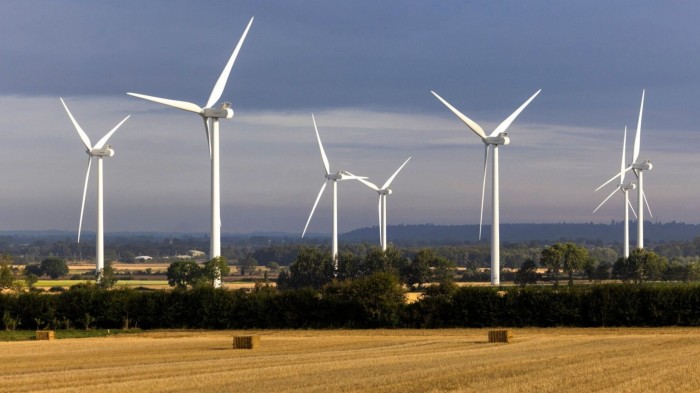Unlock the Editor’s Digest for free
Roula Khalaf, Editor of the FT, selects her favourite stories in this weekly newsletter.
A surge in onshore wind turbines in England has yet to materialise one year on from Labour’s lifting of a de facto ban on new projects.
Planning authorities have not received any applications for new large scale projects since restrictions were eased last July, according to Financial Times analysis of government data.
The fourteen applications submitted between the lifting of the ban and April this year are all for small projects involving one turbine, amounting to a total combined capacity of around nine megawatts — enough for around 9,000 homes.
Twelve projects totalling 600MW are at an earlier stage of development in England and have yet to submit planning applications, according to data from industry group Renewable UK.
That compares with the government’s aim to almost double Britain’s onshore wind capacity by 2030, from around 16 gigawatts to around 27-29 gigawatts, suggesting the bulk of that will need to come from Scotland and Wales.
Developers need to go through lengthy processes before they can apply for planning permission, such as identifying sites and gathering environmental data.
“It can easily be 2-5 years before you are in a position to submit [an application for] planning consent, where it will show up on the database,” said Lisa Christie, director of public and regulatory affairs in the UK for Swedish developer Vattenfall and a member of the UK’s onshore wind task force.
“We certainly see [England] as an exciting market and we are looking at quite a lot of sites, including in the south of England.”
However, the slow progress so far highlights the scale of the challenge as the government tries to develop turbines in England to boost overall clean power supplies and balance out the distribution of turbines across Britain.
Development in recent years has mostly been in Scotland, after David Cameron’s Conservative government put in place highly restrictive planning rules in England in 2015 following opposition from rural communities.
In 2023, Michael Gove, then communities secretary, eased these rules but legal experts said at the time it did not go far enough to encourage developers’ interest.
Planning applications for Scotland, Wales and Northern Ireland show 68 were submitted since Labour took power last July, with an additional 600 filed during England’s de facto ban.
In total there are 528 onshore wind schemes in the pipeline in Scotland, Wales and Northern Ireland — either under construction or awaiting a planning decision — with a total planned capacity of 17.6GW.
Labour went much further days after it won the general election last July, removing rules which meant any local opposition was enough to block a project.
It has since taken further steps to improve the chances of onshore wind projects getting through the planning process in England, and last week set out plans to try to tackle problems such as relationships with local communities and concerns about interference with military and aviation radar.
Responding to the planning application figures, a spokesperson for the Department of Energy said it had laid “strong foundations to reverse a near decade of decline in the industry” but it would “take time for these changes to filter through the planning system”.
RenewableUK’s head of onshore wind delivery James Robottom said: “The de facto ban on onshore wind was in place for nine years, so naturally it takes time to develop new projects from a standing start.”





